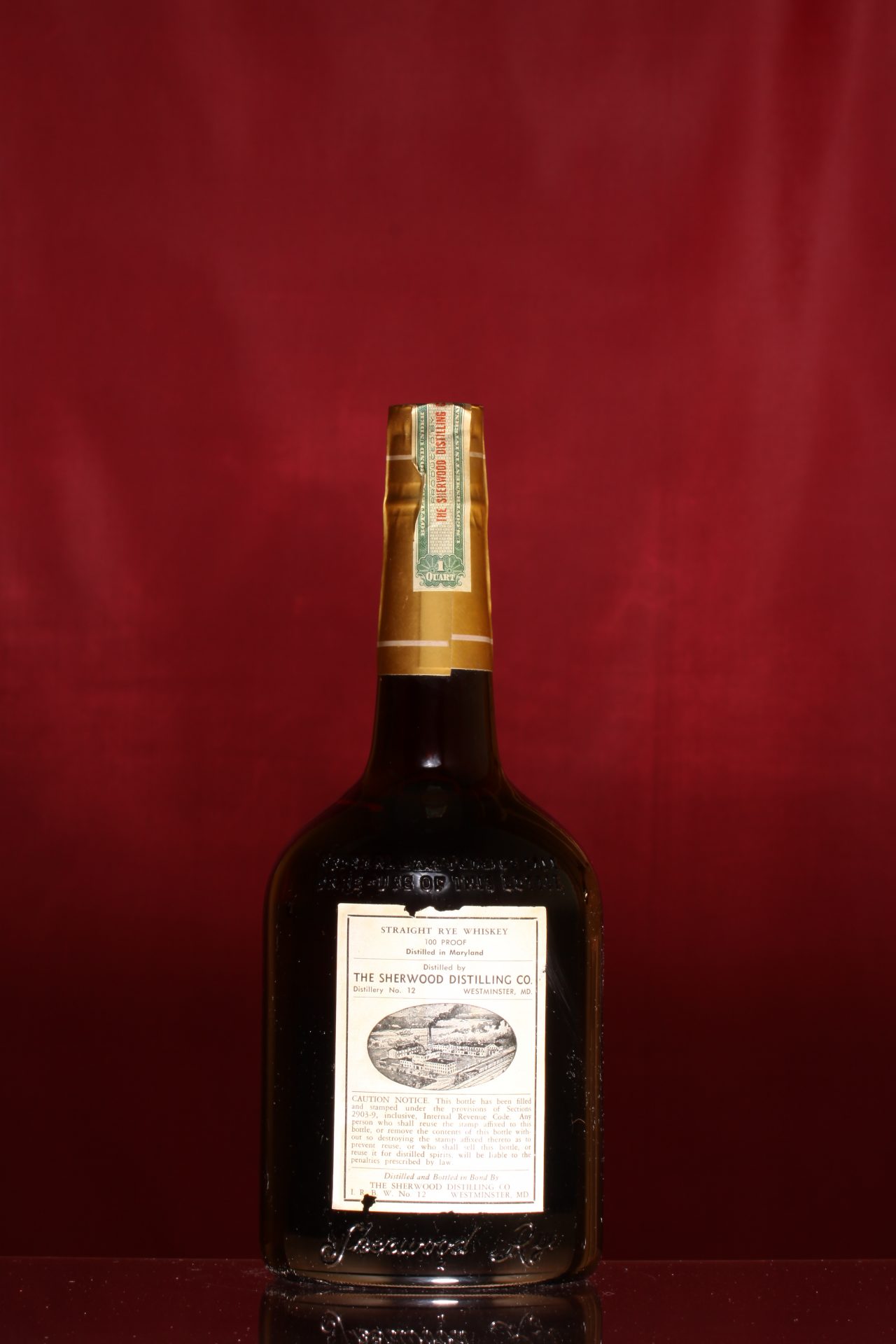SHERWOOD RYE
| Type: | WHISKEY RYE |
| Flavor: | Rye |
| Made From: | Distilled From At Least 51% Rye |
| Produced By: | SHERWOOD DISTILLING COMPANY |
| Origin: | Westminster, Md. U.S.A. |
| Proof: | 100 |
| Age: | 0 |
| Importer: | Made In The U.S.A. |
| Location: | Westminster, Md. |
ONE OF MARYLAND’s best-known rye distilleries, with expressions popular both before and after the prohibition years, was the Sherwood brand. And, as often happened with other old Maryland brands, prohibition found a strong family continuity in the distilling industry traveling a different road from the brand name with which it was once associated.
The town of Cockeysville lies about seventeen miles north of Baltimore on the road that goes to York, Pennsylvania. People from outside of the area are more likely to know it as Hunt Valley, but that name was invented out of nowhere by real estate speculators in the 1960s. Two hundred years earlier, the buffalo and the Shawnee tribes who hunted them gradually gave the area up to white settlers, among whom were the Cockey family, who built a hotel and convinced the Baltimore & Susquehanna railroad to establish a station here. Among the industries taking advantage of the railroad by the late 19th century was a distillery operated by William Lentz and John J. Wight. As best as we can figure out, the distillery was located in the area now occupied by Procter & Gamble’s Noxell plant. Their product was named Sherwood Pure Rye, after a nearby church.
Meanwhile, Baltimore grocer Al Hyatt’s son Edward and his partner Nicholas Griffith operated a whiskey dealership (Griffith & Hyatt) until 1863, when Hyatt moved to New York and teamed up with a gentleman named Clark. By 1868 Hyatt & Clark were able to purchase the Wight distillery in Cockeysville and enlarge it to allow broad-scale producing and marketing of their own brand-name Maryland Rye whiskey. Within ten years the Army’s Medical Purveying Depot in New York was stockpiling Sherwood Rye Whiskey for hospital use. In 1882, after Hyatt & Clark dissolved, Hyatt incorporated the firm as The Sherwood Distilling Co., with himself as president. The relationship between the Hyatts and the Wights must have been a pretty close one as well, for after Hyatt’s death in 1894, company leadership was taken over by John Hyatt Wight.
As early as 1914, Frank L. Wight was working at the distillery, and he continued to do so right up to the day it closed down in compliance with national prohibition. With passage of the 21st Amendment he went on to become a major figure in Maryland’s post-Repeal distilling industry.
But not with the Sherwood brand.
He headed the Frank L. Wight Distilling Co., which built a distillery at Loreley, in the Whitemarsh area further toward the east side of Baltimore, and marketed Sherbrook, Wight’s Old Reserve, and Congressional Club Maryland straight ryes. That distillery was purchased by the Hiram Walker, Inc. of Canada and subsequently shut down when production moved to their Peoria, Illinois facility. Whereupon, Wight organized the Cockeysville Distilling Company and in 1946 he built a distillery just down the street from where the original Sherwood site had stood until the buildings were demolished in 1926. Unable to regain access to the Sherwood brand, Wight produced and marketed instead a Maryland straight rye he called Ryebrook.
Wight’s principal backer was Heublein, Inc., of Connecticut, and following Wight’s death in 1958 they shut down the distillery.
Altogether four generations of Wights distilled whiskey in Maryland, the last being John Hyatt Wight II, who died in 1990 at the age of seventy-eight.


